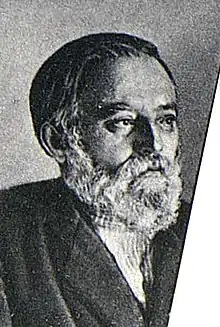Mikhail Tskhakaya
Mikhail Grigoryevich Tskhakaya (Georgian: მიხეილ გრიგოლის ძეცხაკაია, Russian: Михаил Григорьевич Цхакая; 4 May 1865 — 19 March 1950), also known as Barsov, was a Georgian communist. Barsov was a senior leader in the Bolshevik movement in Georgia, having been active in revolutionary politics since 1880. He was one of the five signatories of the Document that formed Soviet Union.

He was born in 1865 in Martvili Municipality. In 1892, he helped found Mesame Dasi (third group), the first Georgian Socialist party. When the Russian Social Democratic Labour Party was founded, he joined it. He saved the young Joseph Stalin from expulsion for Georgian nationalism in 1904. However, Barsov made Stalin write a credo renouncing his views and attend a series of Barsov's lectures on Marxism.[1] Despite this, they remained friends. In July 1906, Tskhakaya was Stalin's witness at his wedding to Kato Svanidze.[2] On September 9, Tskhakaya and Stalin were among just six Bolsheviks at the Social Democratic conference in Tbilisi (the other 36 were Mensheviks).[3] They shared a room at the 5th Congress of the Russian Social Democratic Labour Party in London.[4] Neither were allowed to vote owing to Bolshevism's weakness in Georgia. In 1907, after a series of arrests and deportations, he went into exile in Switzerland where he visited Lenin in Geneva. He returned to Russia in 1917, alongside Lenin on the famous sealed train. From that point onwards, he was an influential leader of the Communist Party of Georgia.[5] He was buried at the Mtatsminda Pantheon.[6]
References
- Simon Sebag Montefiore, Young Stalin, page 101
- Simon Sebag Montefiore, Young Stalin, page 136
- Simon Sebag Montefiore, Young Stalin, page 138
- Simon Sebag Montefiore, Young Stalin, page 146
- Minutes of Second Congress of the Communist International
- Rich, Paul B. (December 4, 2009). Crisis in the Caucasus: Russia, Georgia and the West. London: Routledge. p. 144–145. ISBN 978-0415544290.